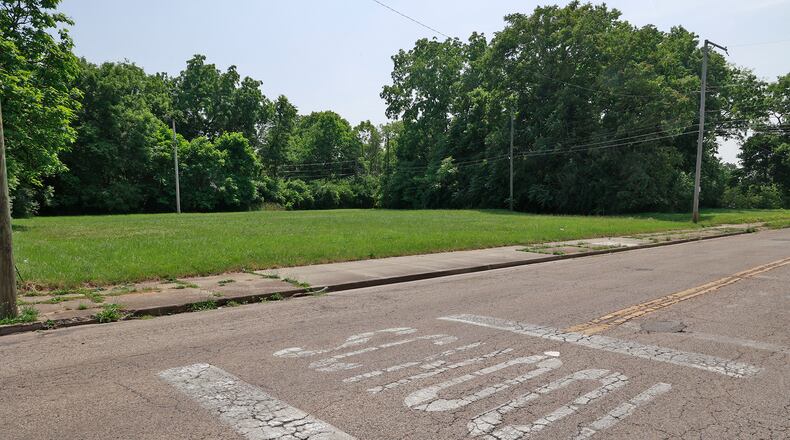Residents of Fair and South Yellow Springs streets offered a major presence and gave passionate voice in opposition to plans to locate a proposed affordable housing complex for those experiencing chronic homelessness across from Fulton Elementary School.
Their efforts resulted in a split vote and the failure of the rezoning effort, an apparent end to the project.
Developer Robert Hellmuth rejected the possibility of relocating the development to another site, saying final plans must be submitted for review in November. That does not leave enough time, he told commissioners, to clear all the processes required for state approval of another site location.
“I had hoped to have this whole rezoning process completed by March, so I was already crunched to meet the state deadline,” he said.
The rezoning required four votes for approval. With the absence of Commissioner Krystal Phillips at the meeting, Assistant Mayor Rob Rue and Commissioner David Estrop voted against the rezoning request. Mayor Warren Copeland and Commissioner Kevin O’Neill voted in favor of the rezoning, but their effort fell short.
Losing the vote means losing the project
The proximity to the elementary school building was just one of the issues residents of the area cited as problematic in the location of the 30-unit apartment complex proposed by RLH Partners Inc. The company has several previously developed housing projects in the city, and the proposed Mulberry Springs apartment unit is one part of multiple housing projects the company currently has on the table.
Hellmuth had offered reassurances to neighborhood residents and offered to help fund improvements to internet access at Fulton Elementary School if rezoning was approved for the project. He and a representative of Sheltered Inc., which manages the Mulberry Terrace Supportive Housing complex, told commissioners that residents of the proposed development would be required to meet screening and background checks that would eliminate anyone from consideration who had a history of violent or sexual offenses or methamphetamine addiction.
Asked if any part of the project could be salvaged, he said that the state does not usually approve parts of projects.
”It’s typically the entire project or nothing,” Hellmuth said.
He said the funding available through the COVID-motivated American Rescue Plan Act was a unique opportunity to access such significant funding. In all, 93% of the $10 million total cost would have come from state and federal sources, with the city required to contribute the remaining 7%. He does not expect the city to pursue another attempt to complete the project.
“It would be a long stretch before the city would be able to allocate the kind of dollars they were getting for this project,” he said. “This was really a one-time opportunity.”
Hellmuth said he develops projects for a living, “and I’m used to not winning all the time.”
The developer said the additional housing would have particularly helped Sheltered Inc., which lost funds from Clark County after the termination of a portion of a $700,000 contract in which the county cited “multiple” violations in the reimbursement of funds in February. Since then, one of two emergency shelters was closed, staffing was reduced, services at low-income Woodford Apartments were ended and the remaining emergency shelter is closed from 8 a.m. to 8 p.m. daily instead of being open for 24 hours.
“They really need the additional housing to help the homeless, and that was echoed by everyone at the meeting,” Hellmuth said. “It’s really too bad they are not going to benefit. They are the ones who really suffered the biggest loss.”
Credit: Bill Lackey
Credit: Bill Lackey
Residents’ concerns
Neighborhood residents listened but most agreed with speaker Camille Hall, who voiced objection to the location of the apartment complex.
“I am not against permanent supportive housing,” she said, “but I am against this rezoning.”
For most neighborhood residents, the issue centered on the project’s location rather than the project itself.
Concerns for children at Fulton Elementary School potentially interacting with individuals who may have mental health or substance abuse history or treatment generated much of the public comment.
In addition, many in the audience expressed frustration that the project had been in the works and on the radar of the city and the developer for the past three years and they were not included in the process until now.
Prior to the vote, James Bacon questioned commissioners about the long-term vision for the area.
“Is this just an isolated, scattered project or part of a bigger plan … that the citizens need to know about going forward so they can participate in and help shape the vision?” Bacon said. “Collaboration and inclusion is a major component in planning … ”
Several cited the city’s Neighborhood Engagement efforts as falling short of providing continuing involvement of residents in community improvement efforts and failing to deliver on previously identified goals.
Karlos Marshall of the Conscious Connect Community Development Corporation, said the Engaged Neighborhood plan calls for the development of a commercial corridor on Yellow Springs Street and asked if that is no longer part of the plan. He also quoted from a document outlining goals of the Engaged Neighborhood plan that Springfield “now needs a permanently provided solution preferably in a way that helps with wealth creation, such as small single family homes, which can be rent to own by tenants.” He noted that the proposed complex does not meet that criteria.
During the meeting, Springfield Community Development Director Shannon Meadows said, “If the site goes away, the dollars will be reallocated to another Ohio community.”
About the Author

